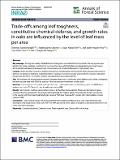Por favor, use este identificador para citar o enlazar a este item:
http://hdl.handle.net/10261/342925COMPARTIR / EXPORTAR:
 SHARE SHARE
 CORE
BASE CORE
BASE
|
|
| Visualizar otros formatos: MARC | Dublin Core | RDF | ORE | MODS | METS | DIDL | DATACITE | |

| Campo DC | Valor | Lengua/Idioma |
|---|---|---|
| dc.contributor.author | Sancho-Knapik, Domingo | es_ES |
| dc.contributor.author | Martín-Sánchez, Rubén | es_ES |
| dc.contributor.author | Alonso-Forn, David | es_ES |
| dc.contributor.author | Peguero-Pina, José Javier | es_ES |
| dc.contributor.author | Ferrio, Juan Pedro | es_ES |
| dc.contributor.author | Gil-Pelegrín, Eustaquio | es_ES |
| dc.date.accessioned | 2024-01-19T09:53:11Z | - |
| dc.date.available | 2024-01-19T09:53:11Z | - |
| dc.date.issued | 2023-10 | - |
| dc.identifier.citation | Sancho-Knapik D, Martín-Sánchez R, Alonso-Forn D, Peguero-Pina JJ, Ferrio JP, Gil-Pelegrín E. Trade-offs among leaf toughness, constitutive chemical defense, and growth rates in oaks are influenced by the level of leaf mass per area. Annals of Forest Science 80: 39 (2023) | es_ES |
| dc.identifier.issn | 1286-4560 | - |
| dc.identifier.uri | http://hdl.handle.net/10261/342925 | - |
| dc.description | 10 Pags.- 4 Figs. Open Access. This article is licensed under a Creative Commons Attribution 4.0 International License. | es_ES |
| dc.description.abstract | Key message Among the variety of leaf defensive strategies to counteract herbivory attacks, the oak species analyzed in this study maximize investment in no more than one, with high-LMA oaks developing very tough leaves and low-LMA oaks favoring between high concentrations of condensed tannins or high growth rates. Context Plants develop a variety of defense strategies to counteract herbivory attacks, from physical and chemical defenses to tolerance strategies. Tradeoffs between strategies have been widely assessed from a resource allocation perspective, but there is a need to consider eventual interactions among them. Aim We evaluate the among-species tradeoff between three main constitutive plant defense traits, while considering the leaf mass per area ratio (LMA) as a proxy of leaf construction investment on area basis. Methods Leaf toughness measured as work of fracture, condensed tannins, and relative growth rate (RGR) were analyzed in a set of 19 Quercus L. species with contrasting LMA. Results Most species had low values either in two or in the three traits analyzed. Moreover, the highest values of work of fracture appeared in the species with high LMA; the highest values of condensed tannins were found in the species with the lowest LMA; and high values of RGR were measured in species with intermediate or lower values of LMA. Conclusion Oaks showed a trade-off among leaf defensive strategies influenced by LMA. Oaks with high LMA developed very tough leaves while oaks with low LMA presented lower values of toughness but favored between one of the two other strategies. | es_ES |
| dc.description.sponsorship | This work was supported by grant CNS2022‑136156 funded by MCIN/ AEI/10.13039/501100011033 and European Union Next Generation EU/ PRTR, by grant PID2019‑106701RR‑I00/AEI/10.13039/501100011033, and by Gobierno de Aragón S74_23R research group. Work of R.M‑S. is supported by a predoctoral Gobierno de Aragón scholarship. Work of DA‑F was supported by an INIA contract BES‑2017–081208. | es_ES |
| dc.language.iso | eng | es_ES |
| dc.publisher | Springer | es_ES |
| dc.relation.isversionof | Publisher's version | es_ES |
| dc.rights | openAccess | es_ES |
| dc.subject | Condensed tannins | es_ES |
| dc.subject | Defensive traits | es_ES |
| dc.subject | Relative growth rate | es_ES |
| dc.subject | Quercus | es_ES |
| dc.subject | Work of fracture | es_ES |
| dc.title | Trade-offs among leaf toughness, constitutive chemical defense, and growth rates in oaks are influenced by the level of leaf mass per area | es_ES |
| dc.type | artículo | es_ES |
| dc.identifier.doi | 10.1186/s13595-023-01204-9 | - |
| dc.description.peerreviewed | Peer reviewed | es_ES |
| dc.relation.publisherversion | https://doi.org/10.1186/s13595-023-01204-9 | es_ES |
| dc.identifier.e-issn | 1297-966X | - |
| dc.rights.license | http://creativecommons.org/licenses/by/4.0/ | es_ES |
| dc.contributor.funder | Ministerio de Ciencia e Innovación (España) | es_ES |
| dc.contributor.funder | Agencia Estatal de Investigación (España) | es_ES |
| dc.contributor.funder | European Commission | es_ES |
| dc.contributor.funder | Gobierno de Aragón | es_ES |
| dc.contributor.funder | CSIC - Instituto Nacional de Investigación y Tecnología Agraria y Alimentaria (INIA) | es_ES |
| dc.relation.csic | Sí | es_ES |
| oprm.item.hasRevision | no ko 0 false | * |
| dc.identifier.funder | http://dx.doi.org/10.13039/501100011033 | es_ES |
| dc.identifier.funder | http://dx.doi.org/10.13039/501100004837 | es_ES |
| dc.identifier.funder | http://dx.doi.org/10.13039/501100010067 | es_ES |
| dc.identifier.funder | http://dx.doi.org/10.13039/501100000780 | es_ES |
| dc.contributor.orcid | Gil-Pelegrín, Eustaquio [0000-0002-4053-6681] | es_ES |
| dc.type.coar | http://purl.org/coar/resource_type/c_6501 | es_ES |
| dc.subject.sdg | Protect, restore and promote sustainable use of terrestrial ecosystems, sustainably manage forests, combat desertification, and halt and reverse land degradation and halt biodiversity loss | es_ES |
| dc.subject.agrovoc | http://aims.fao.org/aos/agrovoc/c_6409 | es_ES |
| dc.subject.agrovoc | http://aims.fao.org/aos/agrovoc/c_1374158672853 | es_ES |
| dc.subject.unesco | http://vocabularies.unesco.org/thesaurus/concept11063 | es_ES |
| item.grantfulltext | open | - |
| item.fulltext | With Fulltext | - |
| item.openairecristype | http://purl.org/coar/resource_type/c_18cf | - |
| item.languageiso639-1 | en | - |
| item.cerifentitytype | Publications | - |
| item.openairetype | artículo | - |
| Aparece en las colecciones: | (EEAD) Artículos | |
Ficheros en este ítem:
| Fichero | Descripción | Tamaño | Formato | |
|---|---|---|---|---|
| Gil-PelegrinE_AnnForestSci_2023.pdf | 1,77 MB | Adobe PDF |  Visualizar/Abrir |
CORE Recommender
Page view(s)
19
checked on 22-may-2024
Download(s)
4
checked on 22-may-2024
Google ScholarTM
Check
Altmetric
Altmetric
Este item está licenciado bajo una Licencia Creative Commons

